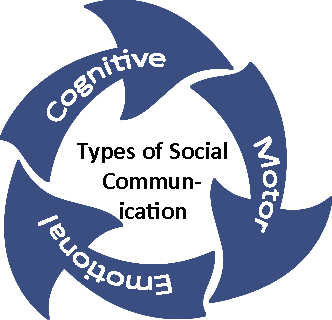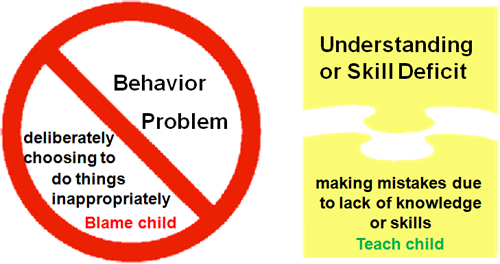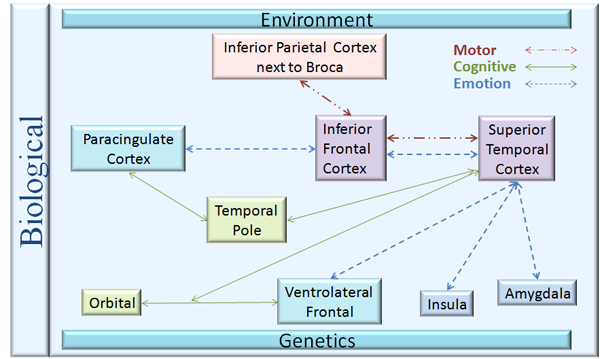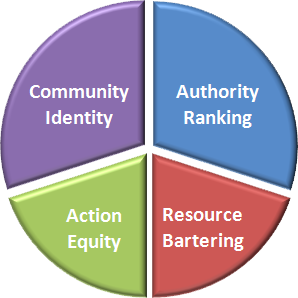
Brains Being Social - Social Communication

There are at least three major forms of social communication: motor, cognitive, emotional. Each of these forms have in distinctly different but sometimes overlapping brain pathways. As in the other forms of communication, they each include comprehension, reasoning, and action or articulation, which take place in distinctly different brain regions. Motor social communication occurs when the individual mirrors the motor responses of another or carries out behavior so that another can imitate. It is exhibited in the tendency to automatically mimic and synchronize facial expressions, vocalizations, postures, and movements with those of another person in a primitive form of sympathy, and also in displaying behavior so that another can learn new skills. Cognitive social communication takes place when one individual observes another to understand their motivations and predict their future behavior. Emotional social communication or affect is communication of emotions, feelings, and physical pain through facial expressions, hand gestures, activity level, voice tone, and laughter or tears. It is found in primates and other species social species, including birds.
Social Core: Security
At the core of being social is security. As infants, our parents take care of us, making us feel secure. This provides the foundation of social relationships. The unpleasant, unfamiliar senses makes a child feel insecure.
As adults we ignore 99% of all our sensory input, because as we developed a world view, we have learned what is safe to ignore. At birth we do not have a world view and all sensory input is equally important. At birth our sensory pathways overlap so that we can develop sensory rich concepts like mother through sight, hearing, and smell. People with global connection dominance develop separate pathways for each sensory system. In people with local connection dominance the separation is not complete, sometimes leading to synesthesia or "union of the senses". Some believe this incomplete sensory separation leads to creativity.
In a verbal society, left-brain verbal children learn much about the world through the words of trusted adults. Right-brain infants are visual and kinesthetic learners, and remains so until verbal pathways are explicitly built. They initially learn about the world visually and kinetically. People labeled as Aspergers and Autistic (ASD) frequently have right-brain and local connection dominance, so how they learn about the world and their world view is very different from left brain global connection dominant people.
Social Cognition
People labeled with ASD have been found to have six universal cognitive challenge areas.
Emotional Referencing: The ability to use an emotional feedback system to learn from the subjective experiences of others.
Social Coordination: The ability to observe and continually regulate one’s behavior in order to participate in spontaneous relationships involving collaboration and exchange of emotions.
Declarative Language: Using language and non-verbal communication to express curiosity, invite others to interact, share perceptions and feelings and coordinate your actions with others.
Flexible thinking: The ability to rapidly adapt, change strategies and alter plans based upon changing circumstances.
Relational Information Processing: The ability to obtain meaning based upon the larger context. Solving problems that have no right-and-wrong solutions.
Foresight and Hindsight: The ability to reflect on past experiences and anticipate potential future scenarios in a productive manner.
(Adapted from Gutstein 2008)
Changing Behaviors
Behavior is a form of motor communication. The two main functions of behavior is to GET something or to ESCAPE or AVOID something. We develop behaviors that have been successful in the past in getting what we desire or escaping what we fear. Society deems some behaviors as inappropriate or problems. To unlearn problem behaviors, the child must be taught equally or more successful behaviors or understandings in getting what he or she desires or escaping what he or she fears, that society deems appropriate. When punishment or rewards are given to a child without their understanding of why, this frequently leads to undesirable behaviors.

To be successful in teaching new behaviors and understandings, requires a major paradigm shift in thinking. In the view of "Behavior Problem" gives impression that the child is deliberately choosing to do things inappropriately. This negative view leads to punishment, blame, criticism, exclusion, and further problem behaviors. With the view of "Understanding or Skill Deficit" gives impression that the child is making mistakes because he has not learned the knowledge or skills necessary to resolve the situation. This positive view leads to teaching, understanding, encouragement, inclusion, and success.
There are three major approaches to changing behavior: Applied Behavior Analysis (ABA), Developmental, and Cognitive. Therapists tend to chose one approach. Each has a different value and a mixed approach is the best. ABA and Developmental approaches deal with skill deficits. Cognitive deals with understanding deficits. ABA focuses on reflexive learning and the lower brain. Developmental and Cognitive focus on frontal cortex learning.
ABA is the application of operant conditioning whose goal is identify what's causing a discrete behavior and teach replacement ones. It is labor intensive and requires the reward to be given 1-3 seconds following the desired behavior. Learning of one skill usually does not extend to other skills. Good candidate skills for ABA is potty training, initial communication, and initial aggression management.
Developmental therapy breaks down complex cognitive skills into component pieces and incrementally teaches the skill. Parents are taught to take the natural developmental processes for cognitive skills, slow them down, make them more explicit for their child’s individual needs. The complex cognition skills usually apply to a broad range of behaviors, so the learning extends to multiple behaviors. Stress management and social cognitive skills are good candidate skills for Developmental therapy.
Cognitive therapy explicitly teaches understanding about the world. World understanding and world view applies to broad behaviors, so has the largest impact. It is the best way to deal with aggression, sensory overload, and self-harm.
Neurobiology of Social Communication

All social communication relies on the activation of neurons that encode action descriptions, the superior temporal cortex (STC).
Motor social communication pathway also includes mirror neurons in the parietal and inferior frontal cortex. Cognitive communication is thought to be implemented by the integrated neural responding of temporo-parietal regions, temporal pole, and paracingulate cortex. Emotional communication is thought to be implemented by the STC, paracingulate cortex, and partially separable systems based on the type of emotion. The pathway includes the amygdala when the emotion is fearful, sad, or happy, the insula for disgust, or ventrolateral frontal cortex for angry expressions.
As long as autism has been recognized, the idea has existed that people with autism are impaired emotionally. People with autism and Aspergers have cognitive and motor social communication challenges, but not emotion. They can have facial recognition challenges, but not problems in facial affect recognition. Whereas, people with psychopathy have emotion social communication challenges but not cognitive and motor communication challenges. Psychopathy is a developmental condition, usually appearing in early childhood. They are charismatic, but have the ability to inflict serious harm to others without remorse. Psychopaths are known for being left thinkers with having less hemisphere connectivity. Autism and psychopathy are opposite conditions. Both can benefit from early sensory and cognitive integration activities. Processing affect decisions takes place in the right hemisphere. Processsing motor and cognitive is dominate in the left hemisphere in the same regions as natural language.
Much is still being learned in this area. Ideas are being over-turned when not supported by neurobiological fact. Mirror neurons and neuron in the left fusiform gyrus, responcible for face recognition, have been to have unfocused receptive fields in people with autism and Aspergers, as if the neuron have not been trained. This supports the symptoms. Fortunately the neuronal fields respond well to dedicated training. This alleviate or reduces the symptoms.
Cross-Cultural Forms of Cognitive Social Communication Domains

Cross-cultural forms of cognitive social communication domains, and to a certain degree cross species, include Community Identity, Authority Ranking, Action Equity, and Resource Bartering. These are found in different cultures and organizations, but take unique forms. Community relationships are based on a concept of a bounded group of individuals; sharing some common entity, and the need to be relatively kind and altruistic to their own kind. There is a tendency to regard the class to which they are members as better than others. The community has shared customs and expectations of duty. Authority Ranking relationships are based on a linearly ordered model of hierarchy along a social dimension. The key social fact is whether a individual is above or below each other individual. Higher ranking people have prestige and privileges, but subordinates are often entitled to protection. Action Equity is based on a model of justice according to natural law or right. Interpersonal or intergroup actions must have an even balance and distributive justice, in-kind reciprocity, eye-for-an-eye revenge, or compensation by equal replacement. The degree in which cumulative action is out of balance is monitored, and action is taken to seek balance. Resource Bartering establishes individual and societal value for resources. Within a given market system, there is always some number of units of a first commodity whose value is at least as great as the value of the second commodity, therefore can be traded.
The rules are frequently unspoken and rarely presented in a systematic manner, yet members often respond strongly to transgressions. People with cognitive social communication challenges need to be explictly taught the rule systems in a systematic manner to build patterns for each of these domains, so that the person can function well within the society. Society and organizations should also examine closely periodically their own rule systems to insure the rules represent their values.
